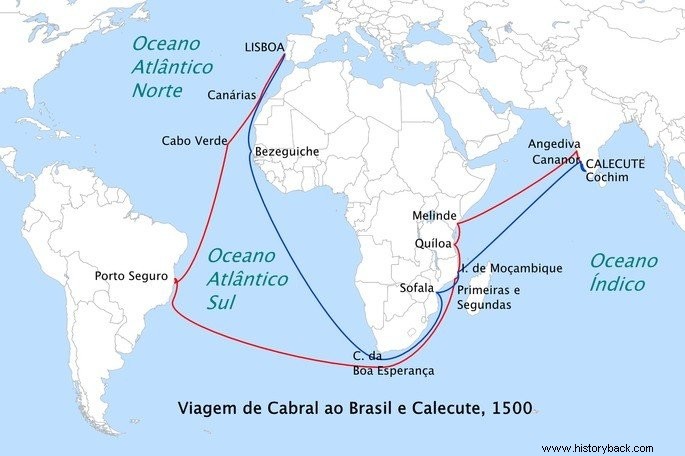The arrival of the Portuguese in Brazil took place on April 22, 1500.
On this day, navigators led by Pedro Álvares Cabral landed in the region of the current city of Porto Seguro. There they remained from the 22nd of April to the 2nd of May, 1500.
The main written testimony of the arrival of the Portuguese was the account of the scribe Pero Vaz de Caminha, which went down in history as the "Letter of Caminha".
The Discovery of Brazil
The expedition that arrived in Brazil on April 22, 1500 - a date that is celebrated as the Discovery of Brazil - began in Lisbon, Portugal, from where navigators left on March 9, 1500.
Pedro Álvares Cabral commanded this expedition and, according to the story, he was the one who "discovered" Brazil.
According to the story, the expedition's destination was Calicut, India, on the path made by Vasco da Gama in 1497-1498. But, several historians agree that, before arriving in India, Cabral had the mission to check if there was land in the south of America.
Cabral's fleet consisted of 9 ships, 3 caravels and 1 shuttle. Between 1200 and 1500 people followed it, including religious, soldiers and interpreters.
The trip went smoothly, with the boats stopping to get water in the Canary Islands and in the Cape Verde archipelago.
Around April 18, the navigators were already close to Brazilian lands, more precisely, close to Bahia de Todos os Santos.
On the 21st, the sailors saw plants, such as the botelho and the rabo d’asno (or donkey’s tail), and the next morning, they saw birds such as the fura-bucho, unmistakable signs that there was land nearby. Later, they saw a mountain and, as it was Easter time, they called it Monte Pascoal.
The navigators thought that Brazil was an island and, for that reason, the first name they gave it was Ilha de Vera Cruz (true, real or true), but later they called it Terra de Santa Cruz. This was a sign that Cabral and the other captains realized that Brazil was a continent and not an island.
Although the Portuguese arrived in Brazil on the 22nd of April, it was only on the 23rd that one of the captains, Nicolau Coelho, disembarked accompanied by some men. On the beach, about twenty indigenous people from the Tupiniquim ethnic group were waiting.
The next morning, the vessels docked and two indigenous people were taken aboard. According to Pero Vaz de Caminha, both were impressed with the chickens, and indicated that there would be gold on land.
Finally, on April 26, Pedro Álvares Cabral disembarked with the religious and ordered an altar to be built, where a mass was celebrated. On May 1, another mass - accompanied by a procession - was celebrated.
In order to ascertain the coordinates where they were, the Portuguese built a large wooden astrolabe and, on the 2nd of May, the boats lifted anchors and set sail for the Indies, leaving two convicts on the coast.

However, the vessel commanded by Gaspar Lemos returned to Portugal to inform King Dom Manuel I about the finding of land. On this occasion, the "Letter of Pero Vaz" would be delivered.
For some historians, the return of Gaspar Lemos to Portugal reinforces the idea that the discovery of Brazil was not intentional, but planned by the Portuguese.
See more :Discovery of Brazil
Historical context of the discovery of Brazil
Cabral's voyage must be understood in the context of the Great Navigations undertaken by Portugal and Spain, in the 15th and 16th centuries.
Both countries were trying to find a way to the Indies and thus trade directly with the Asian continent. In this way, traders from Genoa and Venice would be avoided.
Spain, with the voyage of Christopher Columbus, managed to prove that it was possible to travel towards the east. In turn, the Portuguese sailed the entire African coast.
In order to stop fighting over the maritime domain, Portugal and Spain signed the Treaty of Tordesillas in 1494.
The navigations continued. In 1497-98, Vasco da Gama managed to reach the Indies and, in this way, establish commercial contacts in the region.
In 1500, Cabral's fleet set out with the aim of strengthening these ties. However, it is believed that he should also check if there was land on this side of America.
The oceanic navigations of Portugal and Spain continued throughout the 16th century and the world was never the same.
Read Also :Brazil Discovery Day.
